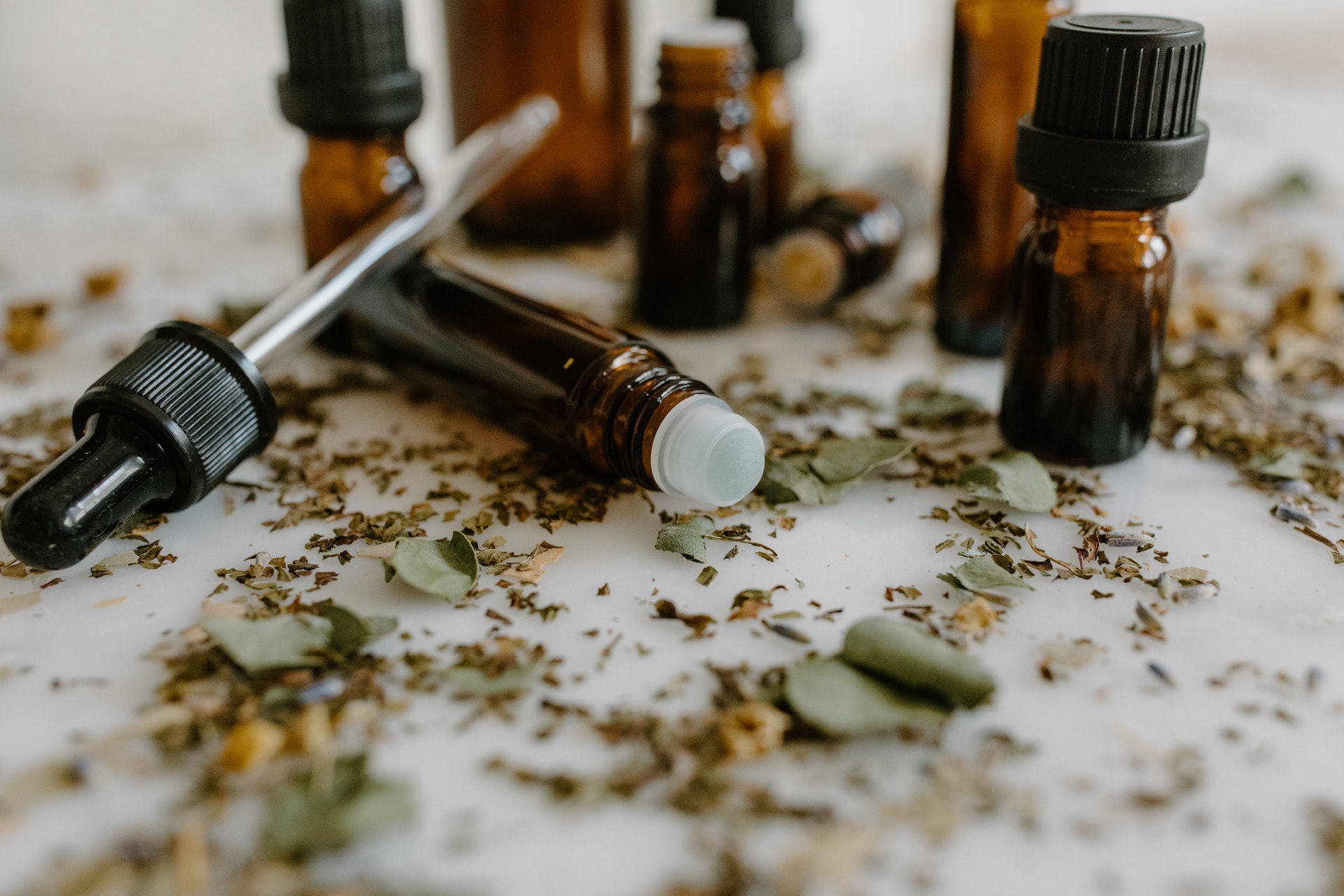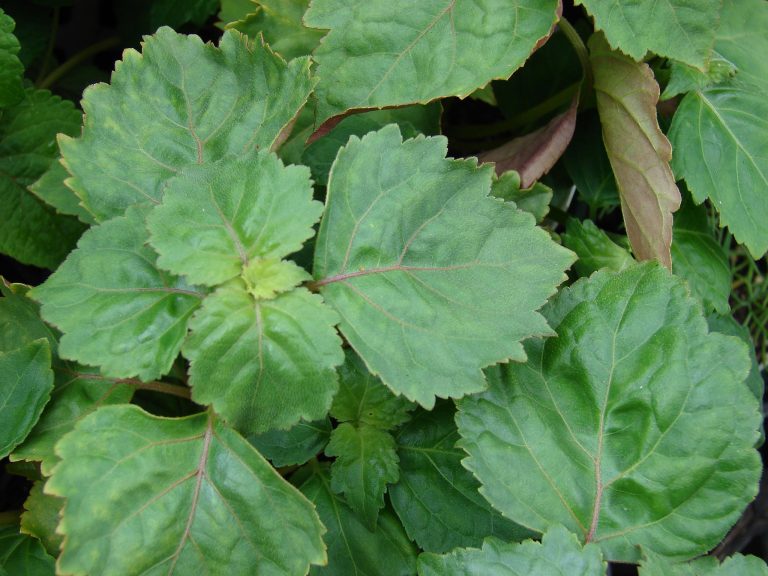Patchouli, Pogostemon cablin, is a perennial member of the mint family. The plant has a complex musky-earthy scent that has been treasured as a fragrance since the time of ancient Egyptians, around 4,500 BC. It was also used therapeutically in traditional Chinese medicine and other Asian cultures.
A native of the Malay Archipelago and West Indies, patchouli grows well in hot, tropical climates; but gardeners in temperate regions can also maintain the plant with some extra care. If the bright green aromatic foliage is not enough to get you on board, let’s look at some of the recognized properties and benefits of patchouli and its unmistakable allure.
Patchouli compounds and their properties
Patchouli is known to contain over 140 compounds, including alkaloids, flavonoids, glycosides, lignins, and terpenoids. The most significant phytochemical compounds found in the plant are α-bulnesene, α-patchoulene, a-guaine, β-patchoulene, eugenol, norpatchoulenol, patchouli alcohol, pogostol, pogostone and seychellene.
Many of these compounds have been tested for their effectiveness in treating various ailments. Patchouli alcohol has been shown to have both anti-inflammatory and antioxidant properties. Scientists researching human lung cancer in Shanghai reported that the compound promoted apoptosis, or the programmed death, of cancer cells, making it a “promising candidate” against tumors. This compound is also responsible for patchouli’s distinct earthy, sweet, and camphoraceous scent.
Eugenol is a strongly scented phenylpropanoid compound with anti-cancer properties and antibiotic properties. The compound has many uses in dentistry and has therapeutic potential in treating liver ailments, bronchitis and cardiovascular diseases. Its spicy scent is valued in personal products, such as perfumes, soaps and lotions.
Success
You are now signed up for our newsletter
Success
Check your email to complete sign up
Norpatchoulenol, too, contributes to the scent of patchouli. Small quantities of this potent tricyclic terpenoid add to the complex aroma of patchouli oil.
Pogostone is notable for its antifungal and antibacterial properties, with research demonstrating its effectiveness against Candida as well as “high activity” against Staphylococcus aureu, Bacillus cereus and Bacillus subtilis.
According to U.S. patent application Ser. No. 10/880,651, the compound α-bulnesene exhibits anti-allergic properties and has promising application for the inhibition or prevention of allergic syndromes.
Traditional Uses of patchouli
Patchouli has been used in traditional Chinese medicine chiefly to nourish and harmonize the Yin, or earth forces, resolve damp, and calm the Shen, or heavenly forces. Its nature is warm and it promotes emotional security while reducing inflammation. It is believed to restore deficient Qi in the spleen and pancreas and ground and stabilize the mind against worry and stress.
The herb was historically used throughout much of Asia to prevent the spread of disease and treat various ailments; including abdominal pain, colds, coughing, dermatitis, headaches, stomach aches, halitosis and diarrhea.
Patchouli fragrance and its benefits
Dried patchouli leaves and tender twigs are steam distilled to produce a robustly aromatic essential oil. The oil is used in incense, perfumes, insect repellent and aromatherapy.
Patchouli’s distinct fragrance does not meet with universal approval. While some are enchanted by its spicy-sweet, musky charm, others find it repulsive. The complexity of its scent leaves lots of room for interpretation, but this oil is one of few that improves with age, which gives depth and sweetness to the aroma. If you haven’t enjoyed patchouli, you may not have encountered a good batch.

Used in aromatherapy, patchouli essential oil is said to be effective in relieving stress, anxiety and low spirits, and to encourage farsightedness, invigoration, lucidity and reason. Many claim that it has aphrodisiac properties as well.
The scent’s ability to repel insects can help deter moths from your closet and mosquitos from your body; while conversely it can also be used to attract pollinators.
Besides its natural applications as a perfume, patchouli oil has been used in many cultures for its beneficial effect on the skin. A wide range of topical uses include dandruff, skin irritations, bites and abrasions, rejuvenation, acne, eczema, fungal issues and skin growths. Although this oil is not one that “burns” it should be added to a carrier oil before applying directly to the skin.
Growing the patchouli plant
A patchouli plant grows in a spreading mound reaching 2-3 feet in optimum conditions. It prefers fertile, moist, well-drained soil with full to partial sun. If you live in a tropical climate, it will do best planted directly in the ground. In temperate climates, this perennial should be grown as a potted plant, since it has zero frost tolerance and must come inside for the colder months in US hardiness zones below 10-12.
Transitioning the plant is important when moving indoors and out again. Acclimate the plant for its indoor location by placing it in a shady spot for a few days. This will allow it time to gradually get used to the lower light and temperature change. Place the plant in a south facing window for maximum sun exposure. Keep the soil moist to prevent sunburn.
Similarly, when all chance of frost is gone, place the plant in a shady spot outdoors for a few days to allow it time to adjust to the brighter light and outdoor temperatures before returning it to its summer location.
Propagation is easily done with stem cuttings in late summer or early fall. To start new plants, use sharp, clean snippers or a knife to cut 2-3 inch sprigs of new growth. Take multiple cuttings to ensure success.
Remove the lower leaves and place the stems in a small jar of water. Covering the jar with aluminum foil or using an opaque glass will help promote root development. After a sprig has grown a good set of roots, place it in a small pot with moist potting soil. Keep the soil moist and cover the container with a translucent material to retain moisture.
Harvest patchouli leaves in the morning for optimum effectiveness. Spread the leaves out to dry, so that they are not touching. Once dry, they can be used in potpourri, ground into incense, or infused in a carrier oil. The leaves can also be enjoyed as a fresh herb, or used in herbal teas.















